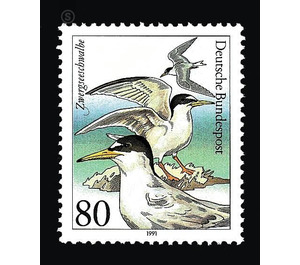Animal welfare - Threatened seabirds - Germany / Federal Republic of Germany 1991 - 80 Pfennig
Theme: Animals
| Country | Germany / Federal Republic of Germany |
| Issue Date | 1991 |
| Face Value | 80.00 |
| Color | multi-colored |
| Perforation | K 13 3/4: 14 |
| Printing Type | 4-color offset printing |
| Stamp Type | Postage stamp |
| Item Type | Stamp |
| Chronological Issue Number | 1413 |
| Chronological Chapter | GER-BRD |
| SID | 385498 |
| In 42 Wishlists | |
The smallest tern in Europe is next to the small size (with a total length of 230 mm but only slightly smaller than the next larger relatives, the black tern with about 240 mm) characterized by the following typical features: yellow beak with black tip (otherwise the European species have red or blackish beaks, the big sandwich tern a black beak with a yellow tip) and a small white forehead triangle. The real habitat of the little tern is the coast, are largely undisturbed island locations, Verlandungszonen, flat sandy beaches, dune landscapes, brackish lagoons and salt lakes. There the birds find themselves in colonies, also breed in common with other terns and snipe birds. For courtship, the male passes as attention to his female small fish. The nest is a shallow depression lined with clam shells or pebbles. The clutch comprises 2 to 3 eggs, in whose incubation, which lasts 20 to 22 days, both sexes take part. The boys are nest-breeders. They hide in the nest environment when a danger threatens (Platzhocker). After 3 weeks, the offspring is airworthy and a little later independent. Little terns feed on small fish, crustaceans, insects, worms and other invertebrates. Like the other relatives, the little tern belongs to the migratory birds, which leave the German breeding grounds from July until September at the latest and return from the West African wintering areas from the end of April to May.


